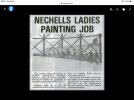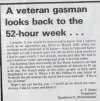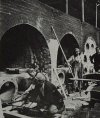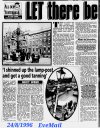postie
Gone but not forgotten. R.I.P.
In a sense Birmingham is the home of gas, as William Murdock came from Cornwall in 1777 to join Boulton and Watt at the Soho Manufactory, where he discovered the use of coal gas for lighting, and gave a public display at the Soho works for the celebration of the Peace of Amiens in 1802. A year later the whole of the works was lit by gas. Murdock designed the necessary gas-fittings which the company soon manufactured for sale, but the borough of Birmingham was content to rely on whale oil for street lighting. Among the last products manufactured at original Soho Works before the move in the 1860s were many gas fittings.
In 1816 tenders were invited for street lighting by gas, and only one offer was received, from a Mr Gostling of London, who had already installed lighting in Westminster. The tender was accepted, and he was immediately asked to extend his contract to another 16 streets, which was beyond his private means. So he set up the Birmingham Gas Company by private Act of Parliament and in 1818 Birmingham had its first street lighting by gas which was manufactured in Gas Street. The company appears not to have been the most efficient, and competition was soon established. The Birmingham and Staffordshire Gas Company was set up by Act of Parliament in 1825, but did not perform much better, although it did open the country’s largest gas works at Swan Village, West Bromwich, in 1829. In the 1830s two unsuccessful attempts were made to set up new companies - the Consumers’ Gas Company and the Equitable Gas Company. The 1849 Kelly’s Director lists the Birmingham Gas Light & Coke Company with works at Gas Street, Fazeley Street and Windsor Street, and the Birmingham & Staffordshire Gas & Coke Company with its Birmingham works at 57 Adderley Street. All these gas works were located next to canals, but the Windsor Street and Swan Village works also had railway access.
The Birmingham Improvement Act of 1851 gave the borough many new responsibilities and powers to discharge them, but the gas companies escaped the net, because their business was not considered a public health matter although, by contrast, Manchester already had a municipal gas service in 1817.
By the 1870s there were 33 municipal gas undertakings in the country. This was at a time when Birmingham reached the peak of its prosperity, and enjoyed the leadership of the Mayor, Joseph Chamberlain, who in 1874 persuaded the Council to vote by 54 votes to two in favour in favour of buying the companies out. An Act of Parliament in July 1875 authorised the deal and the Birmingham Corporation Gas Committee was set up. West Bromwich council decided to keep some independence and obtained parliamentary powers in 1876 to buy from Birmingham the right to establish its own undertaking. Birmingham Corporation retained the Swan Village works to supply Wednesbury and other outlying districts, but West Bromwich built its new works in Oldbury Road at Albion, again close to the canal and the railway, opened in 1880.
From the start, the Birmingham Gas department was a success, making more money which benefited the ratepayers, while gas charges were reduced twice in the first five years. At the same time, the gasworks were modernised and enlarged, a hire-purchase system was set up to sell domestic gas cookers, and pre-payment gas meters were introduced on a large scale. According to Professor Asa Briggs, “It was this undertaking more than any other which made Ralph describe Birmingham as ‘the best-governed city in the world’”. It is no coincidence that the Art Gallery was built over the offices of the Gas Department, which was its landlord. Birmingham’s excellent public libraries were also financed largely from gas revenues. Birmingham also supplied gas to the neighbouring districts of Aston, Handsworth and Yardley, long before it swallowed them up.
With an efficient gas undertaking, the city authorities took little interest in the faltering progress of electric lighting, and it was not until the Birmingham Electric Supply Company was making high profits in the late 1890s that it was taken over by the city. Inevitably, the electricity undertaking grew faster than the gas department during the 20th century, but the City of Birmingham Gas Department put on a brave show into the 1930s, enlarging its statutory area of operation from 125 to 195 square miles, to supply Coleshill, Darlaston, Sutton Coldfield and Wednesbury. Between 1929 and 1931 the Gas Department installed gas connections and slot meters to about 21 000 court and terrace houses without charge. By 1938 one-third of the gas produced was used for manufacturing purposes. Gas was still used largely for street lighting, with spectacular high-pressure fittings in Victoria Square, Now Street, Corporation Street and parts of Hagley Road.
With nationalization in 1949 the undertaking came under the control of the West Midlands Gas Board.
Sources
Gill, C: History of Birmingham - Volume I, Manor and Borough (Oxford University Press, 1952)
Briggs Asa: History of Birmingham - Volume II, Gill, C: History of Birmingham - Volume I, Borough and City (Oxford University Press, 1952)
Contemporary directories
In 1816 tenders were invited for street lighting by gas, and only one offer was received, from a Mr Gostling of London, who had already installed lighting in Westminster. The tender was accepted, and he was immediately asked to extend his contract to another 16 streets, which was beyond his private means. So he set up the Birmingham Gas Company by private Act of Parliament and in 1818 Birmingham had its first street lighting by gas which was manufactured in Gas Street. The company appears not to have been the most efficient, and competition was soon established. The Birmingham and Staffordshire Gas Company was set up by Act of Parliament in 1825, but did not perform much better, although it did open the country’s largest gas works at Swan Village, West Bromwich, in 1829. In the 1830s two unsuccessful attempts were made to set up new companies - the Consumers’ Gas Company and the Equitable Gas Company. The 1849 Kelly’s Director lists the Birmingham Gas Light & Coke Company with works at Gas Street, Fazeley Street and Windsor Street, and the Birmingham & Staffordshire Gas & Coke Company with its Birmingham works at 57 Adderley Street. All these gas works were located next to canals, but the Windsor Street and Swan Village works also had railway access.
The Birmingham Improvement Act of 1851 gave the borough many new responsibilities and powers to discharge them, but the gas companies escaped the net, because their business was not considered a public health matter although, by contrast, Manchester already had a municipal gas service in 1817.
By the 1870s there were 33 municipal gas undertakings in the country. This was at a time when Birmingham reached the peak of its prosperity, and enjoyed the leadership of the Mayor, Joseph Chamberlain, who in 1874 persuaded the Council to vote by 54 votes to two in favour in favour of buying the companies out. An Act of Parliament in July 1875 authorised the deal and the Birmingham Corporation Gas Committee was set up. West Bromwich council decided to keep some independence and obtained parliamentary powers in 1876 to buy from Birmingham the right to establish its own undertaking. Birmingham Corporation retained the Swan Village works to supply Wednesbury and other outlying districts, but West Bromwich built its new works in Oldbury Road at Albion, again close to the canal and the railway, opened in 1880.
From the start, the Birmingham Gas department was a success, making more money which benefited the ratepayers, while gas charges were reduced twice in the first five years. At the same time, the gasworks were modernised and enlarged, a hire-purchase system was set up to sell domestic gas cookers, and pre-payment gas meters were introduced on a large scale. According to Professor Asa Briggs, “It was this undertaking more than any other which made Ralph describe Birmingham as ‘the best-governed city in the world’”. It is no coincidence that the Art Gallery was built over the offices of the Gas Department, which was its landlord. Birmingham’s excellent public libraries were also financed largely from gas revenues. Birmingham also supplied gas to the neighbouring districts of Aston, Handsworth and Yardley, long before it swallowed them up.
With an efficient gas undertaking, the city authorities took little interest in the faltering progress of electric lighting, and it was not until the Birmingham Electric Supply Company was making high profits in the late 1890s that it was taken over by the city. Inevitably, the electricity undertaking grew faster than the gas department during the 20th century, but the City of Birmingham Gas Department put on a brave show into the 1930s, enlarging its statutory area of operation from 125 to 195 square miles, to supply Coleshill, Darlaston, Sutton Coldfield and Wednesbury. Between 1929 and 1931 the Gas Department installed gas connections and slot meters to about 21 000 court and terrace houses without charge. By 1938 one-third of the gas produced was used for manufacturing purposes. Gas was still used largely for street lighting, with spectacular high-pressure fittings in Victoria Square, Now Street, Corporation Street and parts of Hagley Road.
With nationalization in 1949 the undertaking came under the control of the West Midlands Gas Board.
Sources
Gill, C: History of Birmingham - Volume I, Manor and Borough (Oxford University Press, 1952)
Briggs Asa: History of Birmingham - Volume II, Gill, C: History of Birmingham - Volume I, Borough and City (Oxford University Press, 1952)
Contemporary directories










